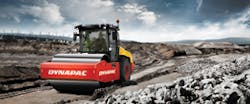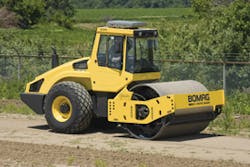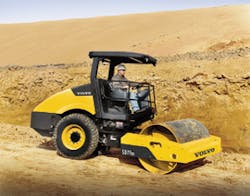One of the most critical elements in building a strong, long-lasting roadway is the compaction of the subgrade, sub-base, and base layers. More than one pavement has failed because the base was inadequate and poorly compacted.
Typically, embankment or subgrade compaction comes first. The multiple layers increase in strength with proximity to the pavement. One of the most common embankment compaction tools is the double-drum padfoot roller, or “sheeps-foot” roller. One of the largest rollers of this type is the Caterpillar 825H, which is a 36-ton machine powered by a 354-horsepower engine. Just down from that is the Cat 815F, a 23-ton machine.
For compacting the embankment, a single-drum vibratory roller with “intelligent compaction” capabilities can be used as the proof roller, says Bomag. Typically weighing 16 tons or more, this type of roller can document soil stiffness of the entire compacted area. Identifying low load-bearing areas before the base and finish courses are applied is a valuable quality control ability.
Sub-base layers are placed next. Each layer or lift is predetermined by the characteristics of the soil. Sub-base layers consisting of cohesive soils are compacted with padfoot rollers. High-speed static compactors or padfoot single-drum rollers utilize their padfeet to penetrate the soil and squeeze out excess water and air voids. That moves the soil particles closer together and increases density. The padfeet compact from the bottom to the top of the lift layer and “walk out” of the material when the required density is achieved. Single-drum vibratory rollers with an operating weight of 11 to 18 tons and having a drum width of 84 inches are typically used for this stage of compaction.
The base layer or layers, are placed on top of the sub-base layers and consist of aggregates in lifts of 6 to 10 inches in thickness. This stage can be compacted with various rollers such as steel-wheeled static rollers, tandem vibratory smooth steel drum rollers, or a pneumatic-tired roller. Bomag says a pneumatic-tired roller is ideally suited to seal this surface and roll out any final irregularities.
Walk-behind vibratory rollers, such as Bomag’s BW 65 H Series, fulfill such applications as sub-bases for building foundations, backfilling, trench compaction, sidewalks, cart paths, and edge work. Light tandem vibratory rollers are used to compact sidewalks, driveways, parking lots, and confined area applications. Midrange tandem vibratory rollers are used for driveways, parking lots, municipal work, city streets, and secondary roads.
Where a radio remote control machine is needed, such as for trench and utility construction, backfilling and foundation area compaction, Bomag’s BMP 8500 series is a good fit. Larger single-drum vibratory rollers in both smooth-drum and padfoot versions are offered by several manufacturers.
Intelligent Compaction
Of the manufacturers contacted for this article, Caterpillar, Bomag, and Hamm offer some version of intelligent soil compaction. Briefly, intelligent compaction provides a real-time measurement of soil stiffness, and some systems can automatically adjust the compactive effort as the required stiffness is reached. Most manufacturers’ soil stiffness numbers correlate to soil density, but do not measure density directly. Density still takes a soil sample to measure.
Intelligent compaction (IC) for soils is not new, and Bomag’s Variocontrol IC (BVC) now is “very popular where contractors require a quality control tool,” says David Dennison, the company’s heavy equipment product manager. The company offers the BVC system on three different soil rollers.
Variocontrol provides an indication of soil stiffness based on the interaction between the roller drum and the stiffness of the soil as it changes with progressive compaction. Two accelerometers see this reaction-or “bounce-back”-several times per second, which indicates load-bearing capacity and compaction progress. The data is shown in real time on an LCD screen located near the roller operator. The BVC drum allows for both manual and automatic reaction to the compaction progress.
Dennison says that the BVC can measure soil stiffness to depths ranging from 11 to 80 inches. Bomag reports its stiffness numbers as an Evib value with units in either meganewtons per meter squared or pounds per square inch. “Correlations to actual soil density are achievable and accurate,” says Dennison.
Hamm calls its intelligent compaction system Hamm Compaction Quality (HCQ). The company notes that compaction is a result of a complex interaction of influencing factors, such as the soil type, the water content of the soil, the stiffness of the subgrade, the number of passes and the weight of the machine. Because of that, Hamm’s system constantly monitors the entire compacting process, instead of observing isolated data separately. HCQ can measure, evaluate and document compaction results in a wide variety of applications in soil and asphalt.
Hamm says the individual modules of its HCQ system are ideally matched to one another.
Hamm’s GPS Navigator system allows satellite tracking of the 3412 HT’s compaction effort.
First, the HCQ Indicator measures and displays the stiffness of soils or asphalt. The stiffness value, called the HMV, indicates the degree of compaction already achieved so that the operator can tell if more rolling is needed. The HCQ Indicator consists of a sensor inside the drum, a processor and a display. Much in the same way Bomag’s system works, the sensor measures the vertical acceleration of the drum. The processor calculates the HMV value from the measured signals and displays this value to the operator in the cab.
Hamm’s HCQ Printer graphically illustrates the measured compaction over a defined area and provides the option of printing out a measurement report. And the HCQ-GPS Navigator, another module, goes one step further-it determines the exact position of the compactor by a global positioning system (GPS). “This easy and convenient measuring system ensures optimal compaction results, provides the operator with effective support and offers numerous possibilities for detailed data analysis,” Hamm says.
The HCQ-GPS Navigator uses a differential GPS (DGPS) receiver. This permits accurate positioning to within a few tenths of a meter. The only preparation required is to install the DGPS receiver in the compactor. Hamm says time-intensive and costly setup of a ground station on the construction site is not necessary.
“You can purchase individual modules of our HCQ system, or buy the whole system as one package,” says Bruce Monical, Hamm marketing manager. “The GPS is separate but you can buy it as part of the whole package.”
To locate a position clearly, Hamm’s GPS must have a visual connection to at least four GPS satellites out of the many that orbit the earth. The DGPS receiver uses the differential signal from an additional satellite. With this additional information, the DGPS receiver pinpoints the position of the roller with very high precision. The DGPS, combined with Hamm’s mapping software, permits complete compaction information to be displayed on the cab monitor in the form of the number of passes or as attained load-bearing capacity.
In addition to load capacity values determined in real time, fixed points or geolines can be displayed. Those help the driver find his way around the construction site. The driver operates the system via a touch-screen monitor with larger user fields and a clearly arranged graphical display. That way the driver can view the compaction map in the desired resolution, thanks to a zoom function.
Caterpillar offers two different compaction measurement technologies. The first is compaction meter value (CMV), is an accelerometer-based system for granular soils. It is only available on smooth-drum soil compactors-CS models. Functioning while the drum vibrates, CMV measures 3 to 4 feet deep in the ground, and provides the operator with a picture of what is beneath the surface. Trained operators can spot the location of hidden anomalies such as rocks or clay balls or areas of poor compaction. Cat says the system can even indicate the need for more moisture to aid compaction.
The second Cat measurement system is called Machine Drive Power (MDP), which the company says is only available from Caterpillar. MDP indicates soil stiffness by measuring rolling resistance. It is available on all Cat B-Series soil compactors-smooth drum as well as padfoot. It can also be used by smooth drum machines equipped with padfoot shell kits. MDP is effective on all soil types, Caterpillar says, and can function when the drum is static or vibrating. MDP measures closer to the depth of the lifts being compacted-around 1 to 2 feet deep.
MDP is more flexible than CMV because it can be used on all soil types and because it measures at a more shallow level than CMV. MDP results can be correlated with readings from portable measuring equipment such as lightweight falling deflectometers and nuclear gauges. Because it does not require the drum to vibrate, there is less risk of decompaction when it is used for proof-rolling.
The Volvo SD77DX single smooth-drum compactor with a 66-inch-wide drum offers features that provide excellent drum performance, serviceability, reliability, and a safe, comfortable environment for the operator, says Volvo. Examples of such features include the following:
- A variable-frequency setting that permits the operator to adapt vibration to the material being compacted
- A high engine-power-to-weight ratio and a high dynamic force to achieve maximum density in a minimum number of passes
- An optional CompAnalyzer that provides users with full data documentation of the compaction process
- A powerful eccentric system with dual amplitude
New From Allied
Allied Construction Products says it pioneered the concept of hydraulically operated Ho-Pac vibratory compactor/drivers. They mount on an excavator or other carrier. Using an eccentric, rotating weight that creates vibrations and impulse energy, a carrier-mounted Ho-Pac provides the needed forces for effective soil compaction.
Allied says its all-new extreme Ho-Pacs now deliver more impact energy, a four-function valve, a variety of mounting configurations and maintenance-free oil splash bearing lubrication. Six models are available with impulse forces ranging up to 40,000 pounds. Because it’s both a compactor and a driver, the Allied Ho-Pac permits even the smallest contractor or municipality to have this dual capability available.
From Case and Dynapac
The SV200 Series vibratory compaction rollers from Case Construction Equipment include four models that the company says provide reliability, durability, serviceability, and ease of operation. Operating weights range from 15,740 to 31,749 pounds. The two smaller models, the SV 208 and SV 210, feature 99-horsepower engines and drum widths of 66 inches. The two larger models, the SV 212 and SC 216 models feature 148-horsepower engines and 84-inch-wide drums.
Dynapac USA recently introduced four new models of its CA-series single-drum vibratory rollers. The CA5000, CA5500, CA6000, and CA6500 have been equipped with a number of improvements over previous models, including optimized drum amplitude, Automatic Bouncing Control, and an overall design that makes it easier to service the equipment.
Dynapac’s Automatic Bouncing Control measures feedback from the drum and eliminates drum bouncing, or over-compacting. The company says the feature is exclusive to Dynapac-and that it improves compaction performance while extending the useful life of the roller by eliminating drum double-jump, which could lead to premature failure of machine components. The CA6000D model also features a governor to avoid compacting at too high a speed.
The Volvo SD77DX single smooth-drum compactor with a 66-inch-wide drum
When Hermann Wacker introduced the rammer in 1930, little did he envision the impact it would have in ensuing years, or that today descendants of his invention can be found on virtually every job site around the world. Wacker Neuson continues in its founder’s footsteps, currently offering an impressive line of rammers featuring two-cycle, four-cycle, and diesel engines to meet the differing demands of today’s job sites. Beginning with the two-stroke BS 30 weighing 32 pounds, Wacker Neuson offers nine gasoline engine models. In addition to these, WN produces its diesel-powered DS 70, whose low carbon-dioxide output makes it a good choice for confined space operations.
Multiquip offers five models in its Mikasa MTX rammer line featuring Honda or Subaru’s ER12 engine, designed for rammer applications. Impact forces range from 3,060 pounds in the MTX60HD model to 3,510 pounds in the MTX80SD. All models sport an automatic shutdown feature in the event of tip over or extended idling.
MBW offers two series of rammers, the R422/442 percussive rammers for granular, cohesive, and mixed soils, and Smart Rammer series, featuring metering to attain maximum performance.
To buy or rent: That’s a question only you can answer. But in broad-brush it depends on the types of jobs you think you’ll be doing.
United Rentals rents a full range of walk-behind plate compactors from Multiquip and Wacker. As well, United rents a range of Impact Vibratory Rammers-also known as “jumping jack” compactors-from Multiquip and Wacker.
United Rentals also rents a lineup of heavy-duty rollers that includes single-drum vibratory soil rollers from Bomag and padfoot and smooth-drum soil rollers-single-drum machines-from Dynapac.











